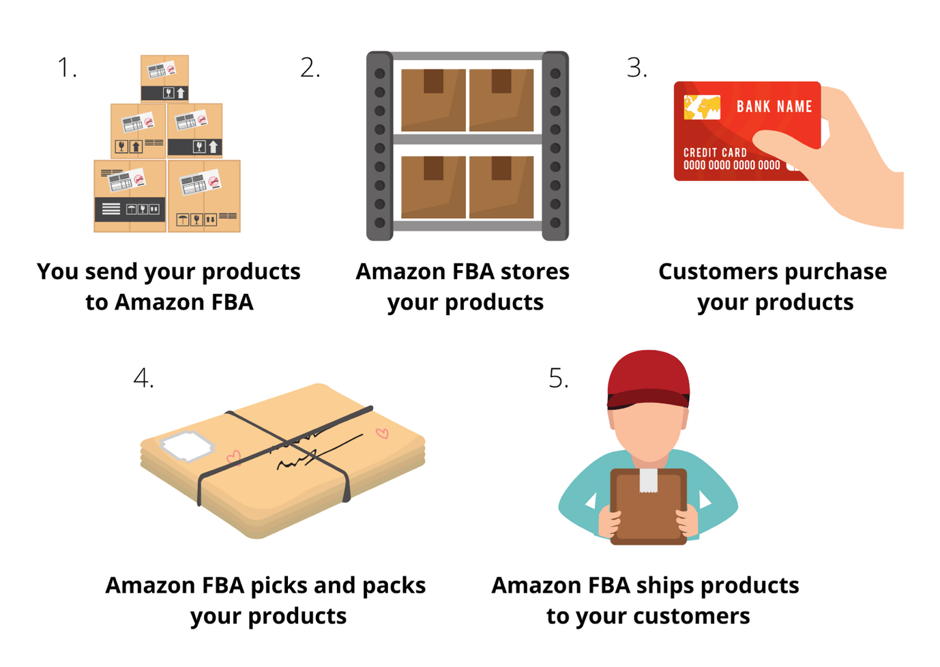Fulfillment by Amazon (FBA) is a service offered by Amazon as a means for third-party sellers to automate their order fulfillment and shipping services. It’s a simple concept: Sellers sell, and Amazon ships.
FBA is an excellent way for many people to find their online sales and marketing niche on the Amazon Marketplace and other channels.
Everyone knows that Amazon works with third-party sellers, but many don’t know the full extent. Third-party seller products account for more than half of all units sold in Amazon stores — with 73% of Amazon sellers taking advantage of FBA.
Anyone can sell something on Amazon, provided they know where and how to do so.
How Does Amazon FBA Work?
Anyone enrolled in an Amazon seller account can let Amazon handle all shipping, including returns and refunds, as well as product warehousing in Amazon’s warehouses, picking and packing and more.
 Sellers send their own products to Amazon, which warehouses everything and then processes the orders as they come in. As long as you handle the sales and make sure Amazon stays stocked with your products, the rest is done for you.
Sellers send their own products to Amazon, which warehouses everything and then processes the orders as they come in. As long as you handle the sales and make sure Amazon stays stocked with your products, the rest is done for you.
What Does Amazon FBA Cost?
Here’s the part everyone always wants to jump to — the cost. It will cost money, but it doesn’t have to be a small fortune.
When deciding on Amazon FBA, you will want to consider the following costs:
Dangerous vs. non-dangerous goods.
Before you can sell on Amazon FBA, you will need to see whether the items you’re selling are categorized as dangerous or non-dangerous goods.
Dangerous or Hazmat products refer to those which can include toxic or flammable parts. Outside of explosives and weapons — which are prohibited — some examples include battery-operated lithium products, items with non-harmful chemicals or magnetic materials.
If the products you’re selling are determined to be dangerous goods, the difference in price between them and a non-dangerous item will be significant, from fulfillment costs to storage fees.
Fulfillment fees
Fulfillment fees include picking and packing orders, shipping and handling, customer service and product returns. The fees are also determined by the weights and dimensions of your products.
There are two primary categories of FBA fulfillment fees, non-apparel and apparel, with pricing differences to match.
-
Non-apparel: Depending on the size of your product and the peak rate, the costs of fulfillment range from $3.07 per item for small-standard to $161.11 per product for special oversized items.
-
Apparel: For apparel products, the pricing is very similar, ranging from $3.43 per item to $161.11.
Inventory storage fees
Amazon charges monthly inventory storage fees based on the daily average volume for the space your inventory occupies in Amazon fulfillment centers.
|
Month |
Standard Size |
Oversize |
|
January – September |
$0.75 per cubic foot |
$0.48 per cubic foot |
|
October – December |
$2.40 per cubic foot |
$1.20 per cubic foot. |
Long-term storage fees
If your inventory has been in a fulfillment center for longer than a year, you will start to be charged a long-term storage fee each month.
This fee will include either $6.90 per cubic foot or $0.15 per unit, depending on whichever amount is greater.
Inventory health report
An Inventory Health Report is an Amazon-generated report that provides FBA and other sellers with a comprehensive breakdown of their inventory, competitive pricing ranges and further important details.
The health report is designed to help FBA sellers with the optimization of their inventory and lower costs with an Inventory Performance Index (IPI) score.